欧洲的顶级餐厅,比如哥本哈根的Noma,已经凭借对采摘食材和可食用昆虫的潮流建立了声誉,并赢得了米其林星级。但在老挝,这并不会引起任何轰动;这种食物一直是该国丰富烹饪景观的一部分。勇敢的美食家米克·希普恩为《占巴·默云老》尝试了一番野性的食物。
我有一个坦白要做。当我邀请西方朋友在万象住宿时,我喜欢带他们去一家老挝餐厅,而不告诉他们,点一份大盘的炸蟋蟀。刚开始时,他们会感到惊讶,反应通常有两种 – 偶尔我的用餐伴侣会毫不犹豫地尝试,但大多数情况下,需要经过10分钟的劝说,他们才会小心翼翼地咬一口酥脆的蟋蟀胸部和腹部,当地称之为"chi nai"或"nak hong tai din",翻译过来是"地下歌手"。事实上,如果你能克服最初咀嚼昆虫的抵触情绪,我向你保证,一盘肥美的炸蟋蟀,撒上白胡椒、炸青柠叶、干辣椒和鱼露,是绝佳的伴随品,与无处不在的冰镇老挝啤酒搭配非常美味。如果你仍然不信服,那么我敦促你简单地将这些美味小吃视为陆地虾!
除了是一种美味的小吃外,蟋蟀还富含营养,是重要的大分子营养物质,蛋白质、脂肪和碳水化合物的丰富来源。事实上,联合国粮食及农业组织最近的一项研究指出,老挝是世界上昆虫消费最高的国家之一,并强调了对健康、食品安全、营养和环境的诸多益处。在老挝,蟋蟀以及其他许多种类的昆虫非常受欢迎,它们不仅在野外捕捉,还商业化养殖,为村民带来可观的收入。
采摘食材
老挝主要是一个乡村和未被破坏的国家,因此采摘食材一直是饮食的重要组成部分。像蕨蕨菜、黄色鸭脚菖蒲、蜂鸟树花和许多其他野生植物、叶子和草药等原料在老挝烹饪中被广泛使用,以创造令人兴奋的口味和质地。采摘的草药被用于汤和咖喱,而一道传统菜肴称为“sup”可以用各种各样的蔬菜制成,用捣碎的姜根、葱、辣椒和芝麻调味。
下次你在老挝餐厅或市场时,要有冒险精神。来一口野性的美食吧!以下是老挝野外食材中值得探索的10种可食用昆虫和采摘美味。
蟋蟀
老挝养殖了几种不同种类的蟋蟀,使它们成为市场上最常见的昆虫。体长5厘米的短尾蟋蟀是亚洲最大的野外蟋蟀。它们生活在地下的洞穴中,雄性在夜间活动时会发出鸣叫声,因此被称为“地下歌手”。蟋蟀被油炸,然后撒上草药和调味料,如鱼露、胡椒和辣椒。

蚂蚁卵
饱满的"蛋卵"(khai mot daeng)和较小、颜色较深的"蛋卵"(khai mot hai)是红蚂蚁和黑蚂蚁的卵,它们都筑巢于树木中。毫无疑问,它们是老挝野外食材中最受欢迎的食物。这些蚂蚁因为通过编织树叶构建巢穴,形成树上的大球而得名。富含营养且美味,蚁卵是季节性的,一般在1月至4月间可获得,但也可以冷冻以备后用。菜肴包括"kaeng pa sai khai mod daeng let pak waan",红蚂蚁卵和小茴香叶炖鱼汤,"khua khai sai khai mot daeng",蚁卵煎蛋,以及"goy khai mot daeng",辣蚂蚁卵沙拉。
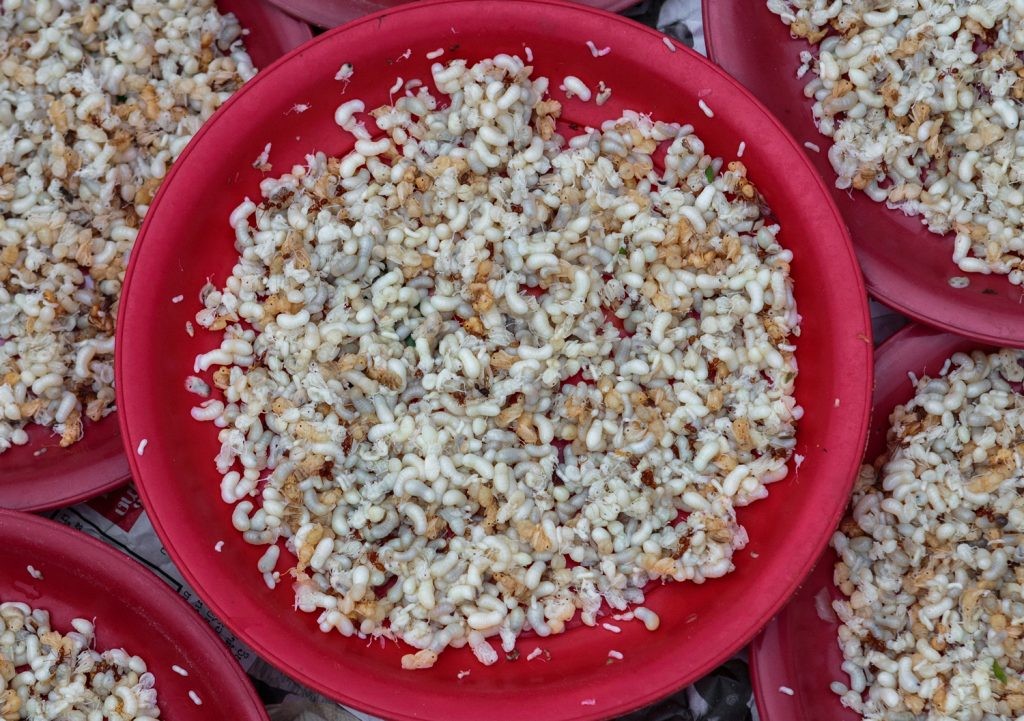
竹蠹虫
这些长约4厘米的虫子,被称为"duang nor mai",是竹蛾(omphisa fuscidentali)或竹蛀蛾的幼虫,正如其名字所示,它们把卵产在竹子的丛生部分。它们在10月到1月的季节里野外采集,并进行商业养殖。被认为是一种美味,富含蛋白质的幼虫会被油炸,是一种受欢迎的啤酒小吃。
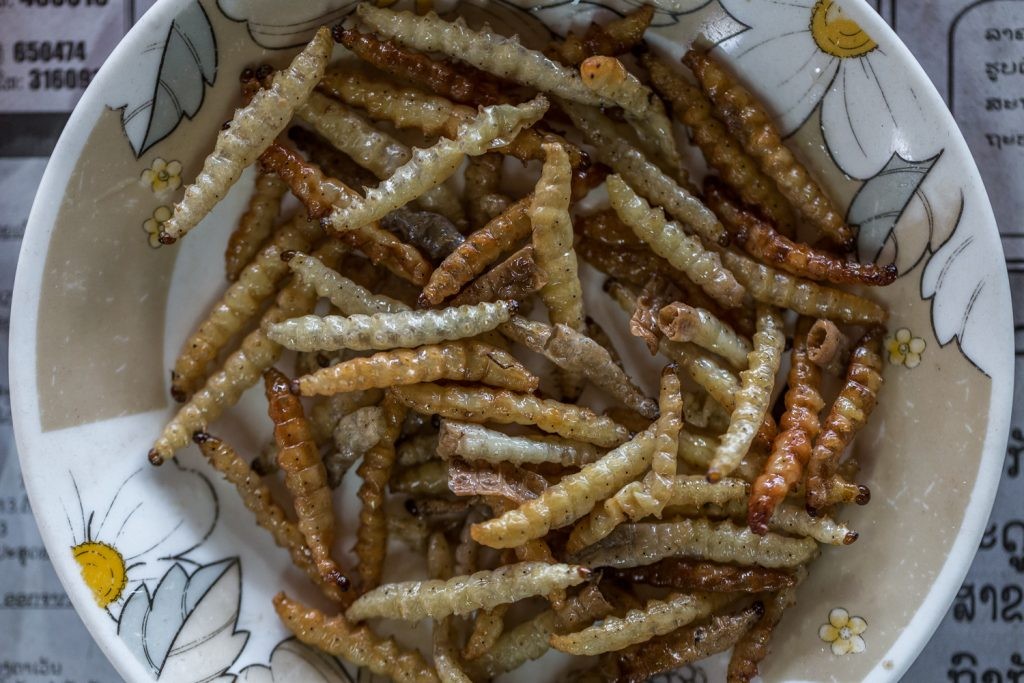
黄蜂和蜜蜂幼虫
并不是所有的昆虫采集都没有风险。栖息在树上的巨大黄蜂或"tor daan"以及经常筑巢在地下的挖洞黄蜂或"tor kum"的幼虫,非常受欢迎作为食物,但成年昆虫非常具有攻击性,使得在采集时需要用烟雾平息它们,因此采集变得极其危险。因此,这些幼虫在6月的季节里价格很高。它们可以以多种方式准备和食用,包括与鸡蛋和草药一起蒸煮。

巨型水甲虫
"Maeng da"是所有可食用昆虫中看起来最令人胆寒的。如果你在市场上被诱惑要捡起一个,要小心它们会咬人。烤制后的"maeng da"内部肉可以加入多道菜肴中,包括"jaew dip",其中它与烤鱼、草药和辣椒混合在一起,以及"pon pa",一道鱼和蔬菜炖菜。这些甲虫具有浓烈的香气,你可能会看到在市场上的购物者闻着它们来选择香气最浓郁的虫子!其味道非常独特,必须一试。
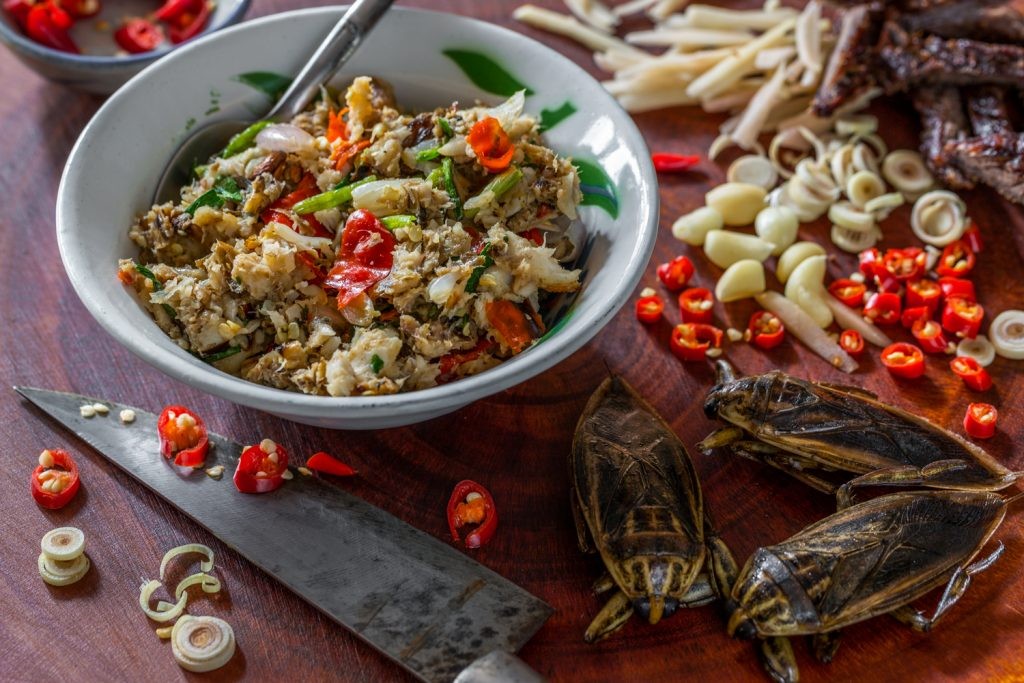
臭虫
在老挝被称为"meng keng"的这种多彩小虫子通常在3月至5月或6月采集。作为自卫,它们分泌一种相当令人不快的液体,可以染色并灼伤皮肤。"meng keng"可以与草药和青柠叶一起炸制,或制成"jaew dip"。老挝还食用许多其他昆虫,包括蜻蜓幼虫、蜣螂、瓢虫、红脚象鼻虫及其幼虫、蝉等等。
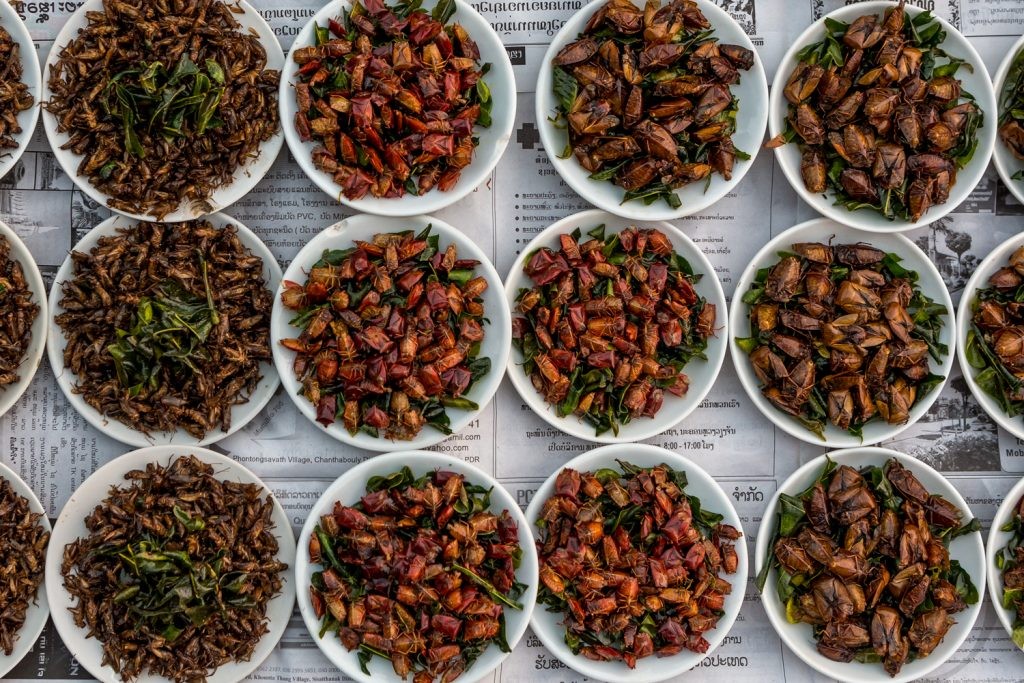
蜂鸟树花
蜂鸟树产生美丽的可食用花朵,被称为"竹花"(dok kare)。这些树可以产生鲜艳的深红色或奶油白色的花朵,它们被加入到汤和咖喱中,比如"gaeng pa sai dok kare",带有蜂鸟树花的鱼咖喱。
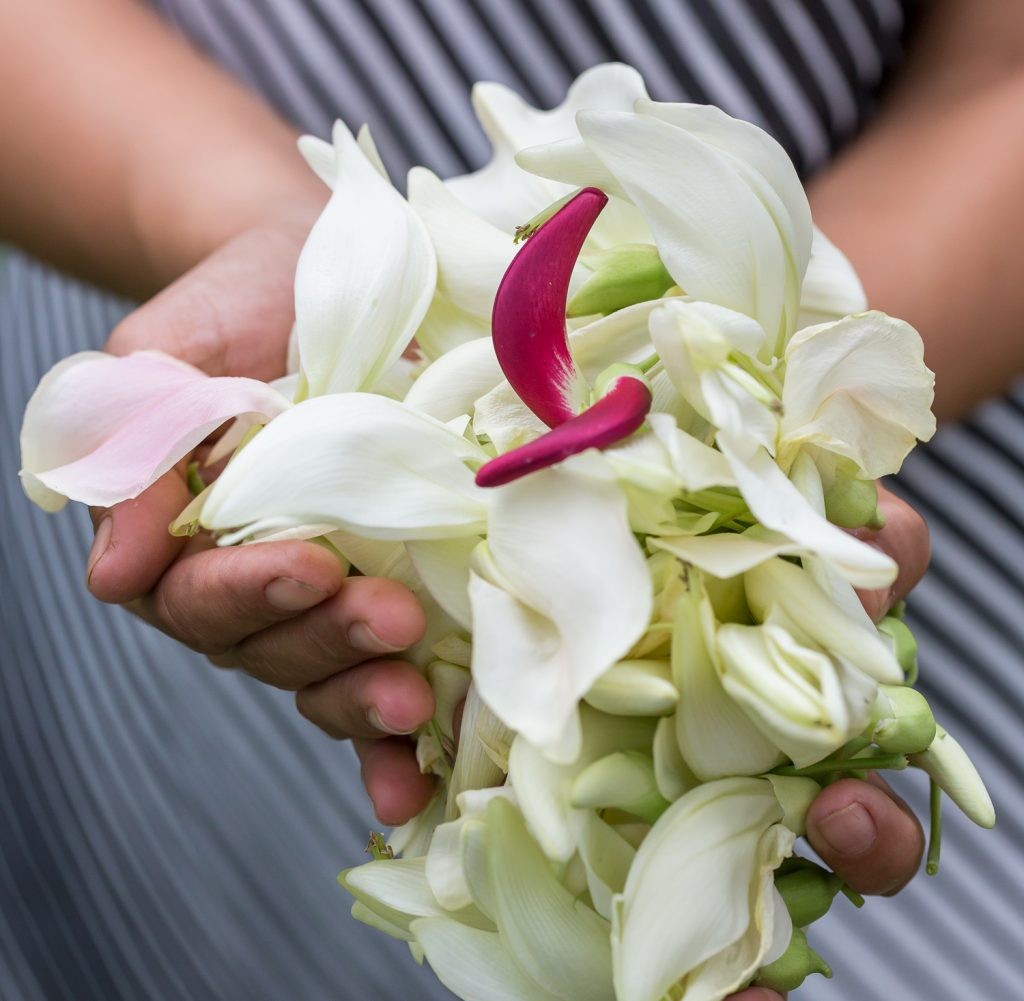
蕨蕨菜尖
蕨蕨菜,或称"pak koot",是一种流行的采摘蔬菜,全年都可以获得。这些嫩嫩的卷曲尖端被用于"sup"或"yam",一道用新鲜辣椒、草药和碎猪肉点缀的辛辣沙拉。
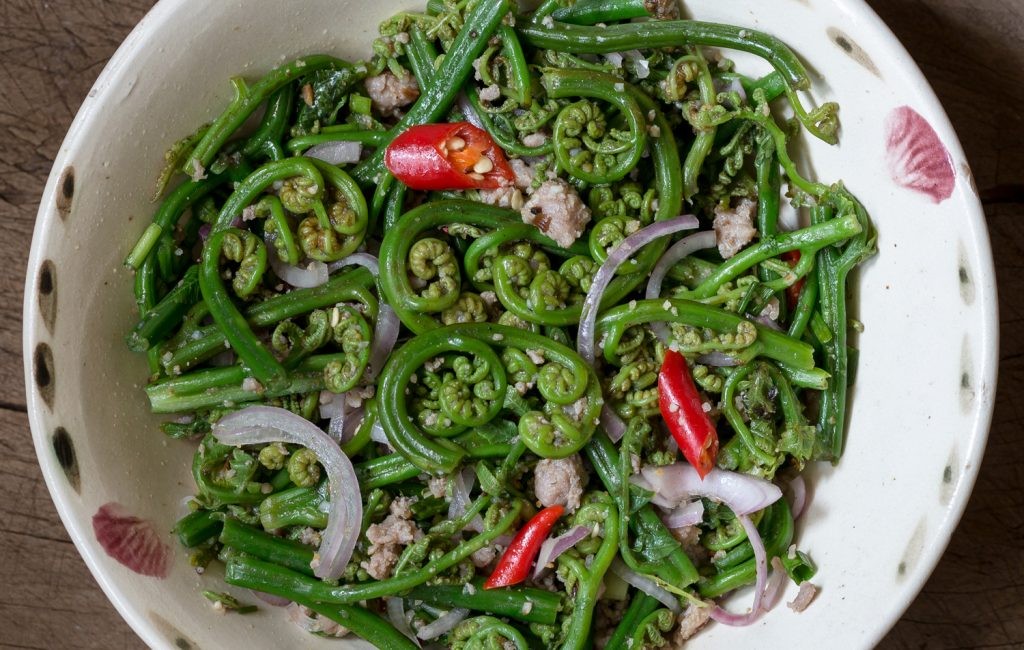
黄色莎菉
黄色莎菉,或称"pak gang jong",是一种可食用的水生鸢尾植物。它的花朵和茎可以被准备成"sup",与大蒜、姜、辣椒、葱和芝麻一起烹制。它原产于墨西哥,在老挝是一种入侵植物,所以通过食用它,你将对环境出一份贡献。

地星指示器蘑菇
这个奇特命名的地星指示器蘑菇是一种小巧的皮革质球状真菌,通常在五月和六月从地下挖出。这种美味而不寻常的蘑菇具有复杂的土壤味道,常用于咖喱或与草药和辣椒一起翻炒。

藻丝(Khai pen)
藻丝是从老挝北部急流河流中采摘的可食用河草。采摘后,会经过多次冲洗以清洁。藻丝会薄薄地铺在一个竹制框架上,类似于手工造纸的过程。然后可以加入薄薄的大蒜和番茄片,以及一些芝麻种子,然后将藻丝晾晒在阳光下。食用时,藻丝只需炸一两秒,然后与"jaew"一起食用,"jaew"是用炭烤大蒜、葱和辣椒的"圣三一"制成的辣酱,另外加入了像番茄、茄子或蘑菇等特色成分。
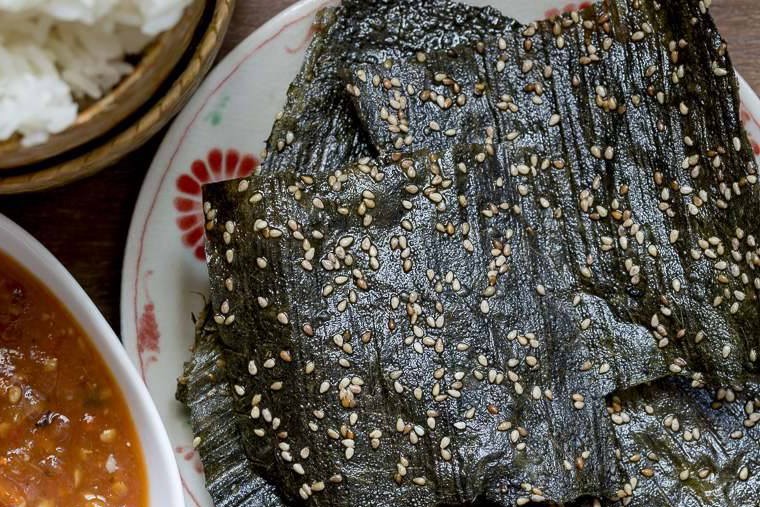
在哪里购买可食用昆虫和采摘食材
在万象,油炸蟋蟀和其他昆虫可以在靠近That Luang的晚上美食市场以及Hengboun和Chao Anou道路的交汇处,以及Khun Bu Lom道路上的Ban Anou夜市找到。
市场上销售的大多数采摘蔬菜是由家庭厨师购买的。很少有餐馆将它们列入菜单。一些例外包括位于万象的Doi Ka Noi餐厅,该餐厅提供每日更换的小型菜单,通常包括一些更不寻常的季节性菜肴,以及位于万象的Kualao餐厅。在琅勃拉邦,Tamarind餐厅可以为提前预订的客人提供“老挝美食冒险”菜单,其中包括一些异国情调的食材。


